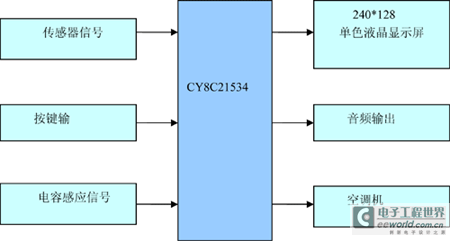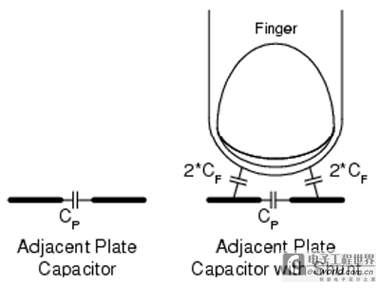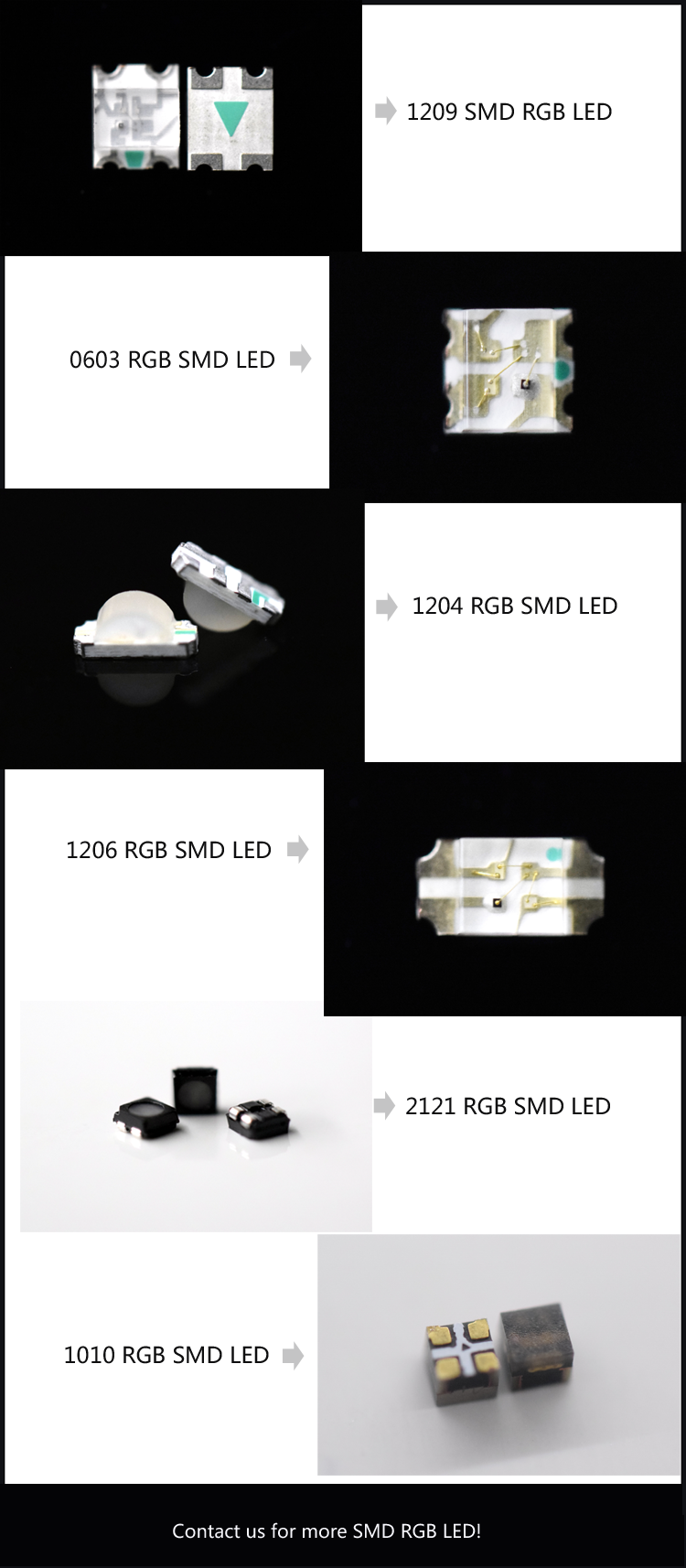Design of Automobile Center Console Panel Based on Capacitive Sensing Technology This article introduces the development process of applying Cypress's PSoC (Programmable System-on-Chip) CY8C 21534 series chips to the car's center console panel. The working principle of the panel and its innovative appearance design highlights the principle of capacitive sensing technology and its application advantages in panel control. In addition, it analyzes the market prospect and commercial value of this center console panel. Background Brief With the development of automotive electronics technology today, there are more and more electronic devices on the vehicle, and it has become necessary to control and coordinate these electronic devices through the on-board computer. However, the more high-end vehicles, the more electronic devices, the more complex the operating system of the on-board computer. If each function corresponds to a button, you can imagine how dazzling the car's center console will be. In this case, how to make the operation interface simple and practical has become a problem that has to be considered. With reference to the operation interface of the iPod, we have developed a car center console panel based on capacitive sensing technology, which greatly reduces the keys, the appearance is simple and beautiful, and the operation is interesting. The car's center console panel has the following functions: 1. Record driving data: The driving data on the homepage includes driving time, mileage, fuel usage, average fuel usage, and average speed. These data are recorded every time you drive, and users can also flip through the previous records. 2. Time and date display: This part of the function is integrated on the right side of the screen. Display in any interface. 3. Temperature display: display indoor and outdoor temperature at the same time. 4. Multimedia player: The system interface supports MP3 player, CD player and radio mode. This part of the function uses a lot of Cypress capacitive sensing technology to make entertainment more interesting. 5. Air conditioning control: This part includes common control functions, such as temperature control, wind control, etc. Overall system design System structure and interface design This system uses the 21534 series chip provided by Cypress, which is characterized by the integration of the capacitive sensing module CSR, which can be directly configured during use, which provides great convenience for the design related to capacitive sensing. This chip has four digital module positions and four analog module positions. Although limited, the main design purpose of this chip is for capacitive sensing control, so a capacitive sensing module (occupying three digital module positions) is configured on this chip And an analog module position) and the counter module (occupying a digital module position) necessary to implement certain controls are just right. (If necessary, you can also use dynamic redistribution technology to add other modules). The system block diagram is shown in Figure 1. Figure 1 System block diagram The display device adopts a four-gray-scale black and white liquid crystal display with a resolution of 240 × 128 pixels, which can be divided into up to four layers for display without a character layer. In this design, two layers of display are used. The first layer is the character layer, which can display the 176 letters, numbers, and symbols that come with the ROM. The second layer is the picture layer, which can control any point on the display. To display the desired graphic. The second layer and the first layer are set to a NAND relationship, so as to achieve the effect of reverse color display when selecting a menu, which is also currently widely used in the selection of menus on LCD screens such as computers and mobile phones. The backlight of the screen adopts the timing control mode, that is, the backlight turns on after pressing the button for 15 seconds, and the information is still displayed after 15 seconds, but the backlight turns off, which does not affect the use and has lower power consumption. The displayed information includes basic information and function information, which are located in two parts divided by vertical lines on the screen. Basic information includes time, date, indoor and outdoor temperature and other information that needs to be displayed but does not need to change positions frequently and does not require buttons to control. It occupies a fixed position on the right side of the screen and is visually stable. The function information includes the information display interface when the FM, CD, air conditioner and other devices are working, which is located on the left side of the screen. Due to the shape design limitation, the number of buttons is very limited, so the same button must be configured with different control functions under different interfaces in order to effectively control the system. In the program, each time a key is pressed, the key variable is assigned, and how the display is displayed depends not only on the variable key, but also on the current display interface to determine the correct operation after pressing the key. In addition, the center button also adds a long key function, that is, pressing the center button for more than 1 second will achieve a function different from a single press to expand the function of the key, which is equivalent to increasing the number of keys. Principle and application of capacitive sensing The capacitive sensing module CSR (CapaciTIve Sensor RelaxaTIon Oscillator) is composed of a capacitive sensor array, an analog multiplexer, a capacitive induction relaxation oscillator and a counter. The structure diagram is shown in Figure 2. Figure 2 Schematic diagram of the capacitive sensing module Capacitive sensors usually consist of a capacitor formed between a copper sheet covering the PCB and ground. The copper sheet is covered with an insulating substance. When the conductor is close to the capacitor, as shown in Figure 3, the capacitance between the copper and ground will change accordingly. Capacitive induction relaxation oscillators produce square waves of different frequencies for different capacitors. Pulse width modulation module and counter calculate the output frequency. By detecting the value of the counter and comparing it with the set threshold, the opening and closing of the capacitive sensing switch can be interrupted. The software part integrates an algorithm that compensates for changes in the environment and the physical characteristics of the sensor. It can also identify the button identification, the position of the slider, and the position of the two-dimensional touch panel, making the capacitive sensing switch stable. Figure 3 Principle of capacitance sensing Capacitive sensing is made into a slider in this design. A finger slides on it to change a specific amount under a specific interface, such as volume under multimedia, air volume under an air-conditioning interface, etc. Compared with the traditional mechanical switch knob, the application of the capacitive induction slider has the advantages of durability, beautiful appearance, and convenient operation. The driver does not need to precisely align that button to adjust, but can adjust the blurring roughly toward the position of the slider. According to the principle of capacitive sensing, the design of the PCB slider of this design is shown in Figure 4. Figure 4 Design of capacitive sensing PCB Shape design Compared with the various center console panels on the market, the design of this center console has a strong visual impact. The off-white display and control parts are embedded in the black imaginary body, and the black buttons are embedded in the white operation interface, which is contrasting and fashionable. There are no cluttered buttons on the entire operation interface. The round touch screen is matched with the buttons around the surrounding, which not only looks well-proportioned but also does not give a monotonous feeling. As shown in Figure 5. Figure 5 Exterior design of car panel software design The software part in this design occupies 8K of FLASH capacity, through a main loop query key input, and then combined with the current interface to form a task. Software flow chart: Figure 6 Software system process Advantages and innovation Simple user interface Abandoning the traditional multi-button design method, the operation interface is composed of only five buttons and a capacitive sensing slider, and can still effectively control multimedia systems including FM radio, multi-disc CD player, DVD player, etc., and car air conditioners , Time and date display, temperature display inside and outside the car and system settings and many other functions. The five buttons can realize different control functions under different conditions, and will not affect the use because of the reduction of buttons. Moreover, the keys are scattered, so long as the direction is roughly judged, the correct operation can be performed. Compared with the button-filled center console that also realizes the above functions, the capacitive sensing center console has its unparalleled advantages in appearance. The simple operation interface design not only gives a visually refreshing feeling, but also uses It can also avoid the driver's misoperation caused by too many buttons or too dense, or prolong the time to find the buttons. fashion appearance Integrating the design elements of the iPod into the car's center console system is a combination of fashion and technology, which is also the direction that designers have always pursued. The innovative design will change the concept that most car center consoles pay more attention to practicality, and truly make the car center console a work of art, giving people a unique feeling. High integration Using only one Cypress 21534 series chip, using its own integrated capacitance sensing module, and assisting with a few buttons to control multiple functions on the car, it replaces the traditional multi-button interface and has a high degree of integration. In this design, almost all pins of the 21534 series chip are used, and the memory utilization rate is also close to 100%, which fully exerts the role of this chip. Here, due to the limitation of conditions, each control is simulated by liquid crystal. In actual use, pin multiplexing can be used to drive the actuator at the same time, which realizes the requirement that one chip replaces multiple chips. Even in the actual application, another chip is assigned to control the LCD screen separately, this design still has a high degree of integration. Save development time Using the capacitive sensing module integrated with the Cypress21 series chip to develop an inductive car center console operating system, compared with other single-chip computers, first of all, it has advantages in time and programming, while also saving time and effort. In addition, the modular programming method possessed by the PSoC system is very convenient, and the API functions that can be directly called greatly shorten the chip development time. The advantages of visually configuring the parameters of the system, modules, and pins are that they do not forget the configuration of a parameter, and do not need to remember the register name and the specific meaning of each person, which also saves the time of consulting the manual. Application of capacitive sensing technology This is the most distinctive design of this center console. Capacitive sensing control has its unparalleled advantages compared to traditional button control. First of all, the shape of the slider can be arbitrarily determined, which provides the possibility of a circular sensing area and provides a premise for a beautiful shape design. Secondly, the capacitive sensing part is composed of a metal diaphragm on the circuit board, covered with a wear-resistant surface cover, which will not cause wear or failure due to too many presses, and its reliability is much better than ordinary keys. Third, the design of the slider can quickly increase or decrease when selecting menus and adjusting some analog quantities (such as volume, air-conditioning temperature, wind power, etc.), without having to repeat keys repeatedly, saving operation time. The convenient and fast operation really meets the requirements of people for the control interface. Fourth, the introduction of capacitive sensing technology to the car panel not only reduces the complexity of mold opening, manufacturing, and assembly of the car panel because of the reduction of keys, but also increases the convenience and fun of use-when tired of the widely used keys After the interface, the slider is indeed interesting and therefore more attractive. Driving pleasure is not only provided by traditional car performance, but also the small center console panel can make the driving process fun and interesting.
This little SMD LED are largely used for kinds of electronic product, for example: LED indicator, LED back light or some DIY led project. These small SMD RGB LED might not easy for weld by our hand because the small size. However, because of this small size, this RGB SMD LED are easier fit with kinds of small size PCB board.
If you really need some small size RGB LED for your project. They won't let you down! Contact us for this SMD RGB LED!
SMD RGB LED RGB SMD LED, 0603 RGB LED, 0805 RGB LED, 1204 RGB LED, 3227 RGB LED Shenzhen Best LED Opto-electronic Co.,Ltd , https://www.bestsmd.com





